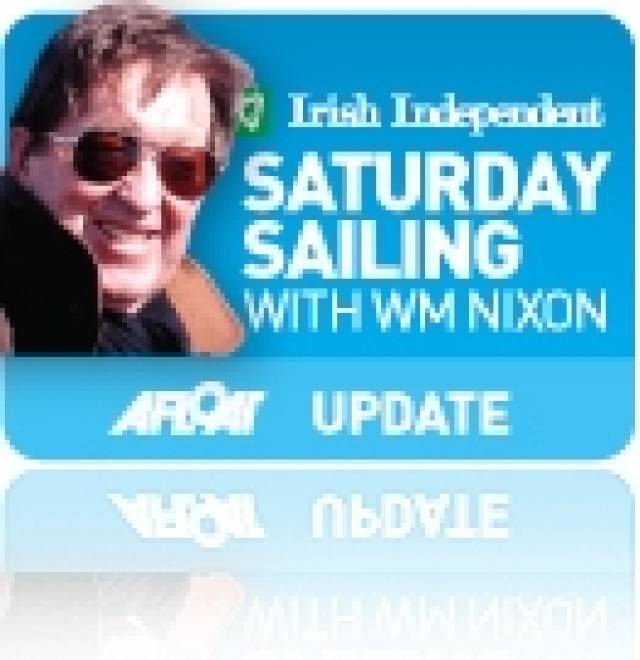#marinas – It was only fifteen years ago that ocean voyager Paddy Barry set off in his much-travelled Galway Hooker St Patrick for a cruise round Ireland. He completed it, and he also succeeded in his secondary objective of seeing if it was still possible to do the circuit almost entirely without stops at anchorages described in detail in the Irish Cruising Club Sailing Directions.
By 1998, the Ireland circuit was no big deal, so you needed this frisson of exploration to add an extra zest. After all, Rob Henshall from Fermanagh had done the circuit unaccompanied in a Laser, and also alone on a windsurfer. But cruising boats were still so relatively rare on much of the Atlantic seaboard that it had been accepted that the ICC guides were bound to have gaps, as they relied almost exclusively on the voluntary input of information.
Then too, just fifteen years ago, the absence of convenient berthing and easy shore access was something else which made the more distant coastlines unknown places. And it wasn't in just the remoter areas that you had to face this problem. Even if you could manage to get comfortably anchored or moored, the business of getting ashore at anchorages on all coastlines could still be a struggle, much exacerbated if you had children or people with impaired mobility. For many Irish harbours, the minimal comfort and convenience of a landing pontoon was still an aspiration rather than the reality.
Back in 1995, Afloat Magazine first published a comprehensive Irish Marina Guide. It had to include all the inland waterways marinas to add the respectability of numbers, for the coastal marinas were still woefully few. And in a pre-prosperity Ireland in which the very name of "marina" aroused prejudice, new projects to provide a few berths in hostile harbours had to resort to euphemisms. "Boat Park" and "Convenience Berthing" and "Disabled Landing" were marinas by any other name. It was a case of whatever you're having yourself, any name you like, but just let's get on with it and have one, and try a taste of boating in late 20th Century style.
But now, things have certainly changed since the days you could cruise round Ireland and stay overnight in "unknown" anchorages. And a very encouraging number of harbours and anchorages have acquired the convenience and safety of a proper pontoon, where at the very least your crew can easily access your tender, and usually you can bring the boat alongside for short visits and the ease of getting gear, equipment and people directly on board.
Perhaps most interesting of all, however, is that marinas of all sizes - and happy to call themselves marinas - have appeared on nearly all coastlines, and sometimes in the most unexpected places, such that the Afloat.ie Marinas Guide currently lists 67 establishments, and we expect that number to steadily increase as the economy slowly revives. The realization of this enormous and welcome transformation is clearest when you study the recently-published 13th Edition of the Irish Cruising Club Sailing Directions for the South & West Coasts of Ireland.
When West Cork-based Norman Kean took over the job as Honorary Editor of the ICC's two pilotage books, he set out to make a round Ireland cruise like that of St Patrick in 1998 using only unknown anchorages, into an impossibility. It was a massively ambitious project, as Ireland's coastline measured in detail can be something like 4000 kilometres long.
But this Courtmacsherry Cyclone, ably assisted by his wife Geraldine, has worked miracles of research and productivity. Yet even by Norman Kean's high standards, this latest 13th Edition of the S & W book is a game changer, a masterwork, one of the best in the entire world, 356 pages of high quality information well amplified with clear plans, and profusely illustrated with photos all of which are informative and many - particularly the aerial ones by Kevin Dwyer - are beautiful evocations of an utterly lovely coastline which just occasionally we might too easily take for granted.
The previous 12th Edition was published in 2008, so obviously the difference is that projects which had only just been put in hand in the Celtic Tiger years are seen in this new book at various levels of fruition. If you find the memories of that crazy time depressing, cheer up. This book should encourage you to think that some lasting good – as with our excellent new motorway system – came out of that era of shared lunacy. While property values may have gone with the wind, the improvements to the coastal infrastructure are of lasting benefit which we can begin to enjoy properly as the economic wheels start to turn again.
Apart from its usefulness as an aid to navigation and pilotage, the 13th Edition a fascinating read in itself, as it takes you along two of our most interesting coastlines, and we get an insight into the way the various harbour authorities are seeking to embrace new opportunities. In several cases, it is County Councils which have been prepared to stick their heads above the marina development parapet.
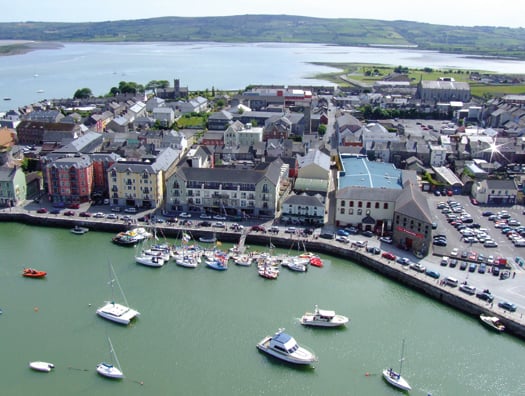
High water in Dungarvan Harbour, and an impressive fleet is gathered at the sailing club's pontoon. Photo: Donal Walsh
For some years we saw on the east coast how Wicklow CC got dog's abuse from trying to do something useful with Greystones Harbour. But now that the marina is finally up and running with boats coming in and adding new life and interest to the place, it doesn't seem such a crazy idea after all.
Last week in this blog we were discussing how Wexford County Council had brought vision and energy to the development of Kilmore Quay on the south coast, which these days is a national pace setter showing how best to combine different uses and sensibly utilise space. It was certainly a new era when the marina there was opened by all the top honchos in local authority and government nearly two decades ago. We probably still had a Department of the Marine back then, and it was such a time of hope, with the buzz at Kilmore so good, that though my mother-in-law's daughter and I had gone down expecting to return that same evening, it was well into the following afternoon when we reappeared at Command HQ.
Further west along the south coast, the new book has an intriguing aerial photo by Donal Walsh showing high water in Dungarvan Harbour, and the club pontoon well filled with yachts in regatta mode. For sure, it's a bit different when the tide goes out. But it's a useful reminder that the traditional perception of the coast between Waterford Estuary and Cork Harbour as a cruising desert is a complete nonsense.
Kinsale is almost a cliché for the perfect cruising port, but the 13th Edition makes us look at it anew with a Kevin Dwyer aerial pic which I hand't seen before, taken from due south. Properly speaking, West Cork is anywhere west of Cork city. But in reality West Cork doesn't properly begin until you're west of the Bandon River which flows through Kinsale Harbour. This photo says it all – the way that the crowded little town of Kinsale on the northeast side is a bustling cosmopolitan port, yet all you have to do is cross the bridge and immediately you're slowing down to West Cork speed and the relaxed atmosphere of Castlepark which – very welcome for families – even has its own neat little south-facing beach along a short sandy lane.

A brisk norwest wind makes things lively at Baltimore's crowded pontoon. In such conditions, there's much better shelter at the pontoon across at Sherkin Island. Photo: Edi Keating
Further west, busy Baltimore has battled for years to deal with conflicting demands on its limited public waterfront space. While the pontoon gives heroic service, in a brisk nor'wester it can verge on being very uncomfortable, and the photo by Edi Keating usefully illustrates that when conditions are like this, a sensible cruising crew will go over to the shelter at the Sherkin Island pontoon.
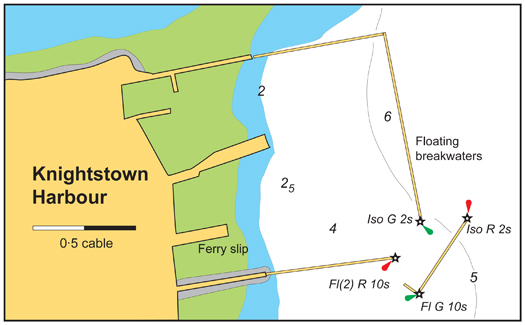
Around on the Kerry coast, there has been much activity with the floating breakwaters of a marina for Kerry County Council at Knightstown on Valentia Island. When eventually finished, it could have hundreds of berths, but for now it is considered permanent enough to be included in the new ICC book, and here it is for all to see – the longest landing pontoons in Ireland.

Paradise almost lost – the ruins of Paradise House are the last relics of ould dacency above the anchorage in the Fergus River Photo: Geraldine Hennigan

The anchorage at Paradise. Lt William Henn brought his hundred foot America's Cup-challenging steel cutter Galatea in here. Photo: Geraldine Hennigan
With its sluicing tides and acres of gooey mud, the Shannon Estuary is not to everyone's cruising taste, but Norman Kean was determined to do it from end to end. Among the islands at the mouth of the Fergus river on the north shore of the great estuary he found Paradise north of Kildysart – the remains of Paradise House, family home of 1886 America's Cup challenger William Henn, and the sweet little anchorage below it where the gallant Lieutenant Henn brought his hundred foot cutter Galatea for a visit.

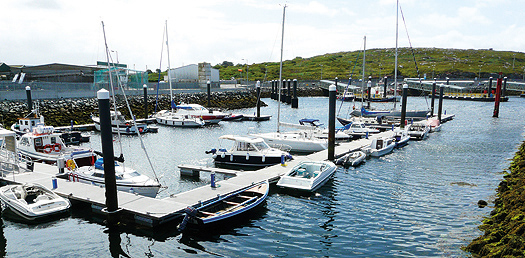
The marina at Rossaveal is already popular Photo: Geraldine Hennigan
Up in Galway Bay, did you know there is now a marina at Rossaveal, that uber-busy Aran Islands ferryport and fishing harbour on the threshold of Connemara? Well, when they were doing the most recent re-development of Rossaveal, somebody did a bit of thinking outside the usual narrow box, and the result is a very handy little facility which already looks to be well filled, but there's room for more, and it's a very useful location.
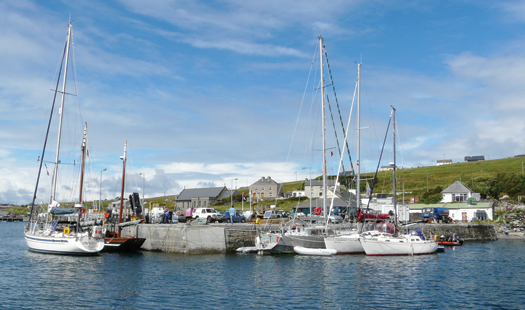
The flotilla gathered at Inishbofin inner quay includes (left to right) the Arctic voyaging Arctic Fern (John Coyle), Dr Michael Brogan's ketch-rigged Galway hooker Mac Duach, the high latitudes cruiser Northabout (Jarlath Cunnane) and the Vancouver 28 Colla Voce (Pat Lavelle). Photo: Geraldine Hennigan
Of course, the dictating factor on any coastal marina is dealing with the ever present tides, but every cruising enthusiast likes to take a photo of their favourite little quayside in the convenience of high tide on a summer's day. Norman Kean has indulged the ICC's active western membership with a happy snap of some very distinguished boats rafted up at high water at the inner quay at Inishbofin, with Day's pub only a matter of yards away, and all well with the world until the tide falls. Even then, it's not the worst place to dry out alongside, and you'll note that Pat Lavelle's Vancouver 28 Colla Voce is a Bofin regular, and has a leg fitted.

Rosmoney's brand new pontoon. The boat is a 17ft French-designed pram built by Jarlath Cunnane Photo: Rory Casey
On up the coast, the new pontoon at Rosmoney Quay among the islands at the head of Clew Bay beside Mayo SC's well-filled anchorage was commissioned too late to be included in the new ICC book. But we have it here just to show that sometimes it is possible to draw level with the Kean machine, even if you never actually get ahead. MSC Commodore Rory Casey says that it's such a success they're going to have to be very careful that people don't hog it, but instead clear out just as soon as they've completed the essential tasks it's designed to facilitate.
Sligo has been a port seldom enough visited by cruising yachts. It's way off the beaten track if you're determinedly on the round Ireland circuit, and the two main sailing centres in the area – Rosses Point and Mullaghmore – have sometimes uncomfortable anchorages, Mullaghmore being open to the north, while the Rosses Point moorings are very tide rode.
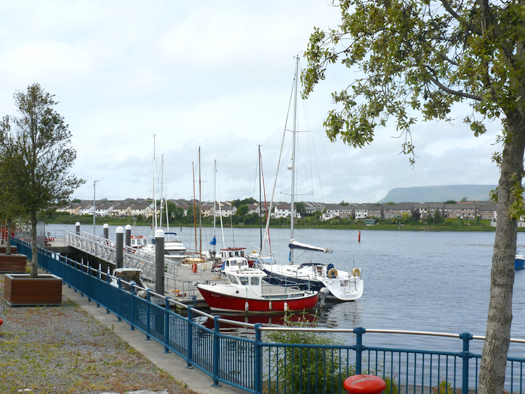
The pontoon in the heart of Sligo provides excellent access to an interesting town Photo: W M Nixon
But now there's a pontoon in Sligo itself, which is so handy that Darryl Hughes, the owner of the beautifully-restored 1937 43ft Tyrrell ketch Maybird, bases himself there when he makes his annual visit to the Yeats Summer School at the end of July. He's still the only Yeats aficionado who sails to the Summer School, but it's early days yet – the pontoon is still thought of as new.
Up the coast at Mullaghmore, they've worked a little miracle. The harbour is very much a drying basin, and the anchorage off it can be mighty lumpy. But with some judicious use of quite a lot of rock armour, they've created snug little corner just outside the harbour mouth and installed a fine big pontoon. The depth alongside may go down to 0.6 metres on the lowest tides, but most of the time most boats can nip alongside for convenient embarkation and unloading, and it's a major convenience and safety addition to the facilities of the harbour.
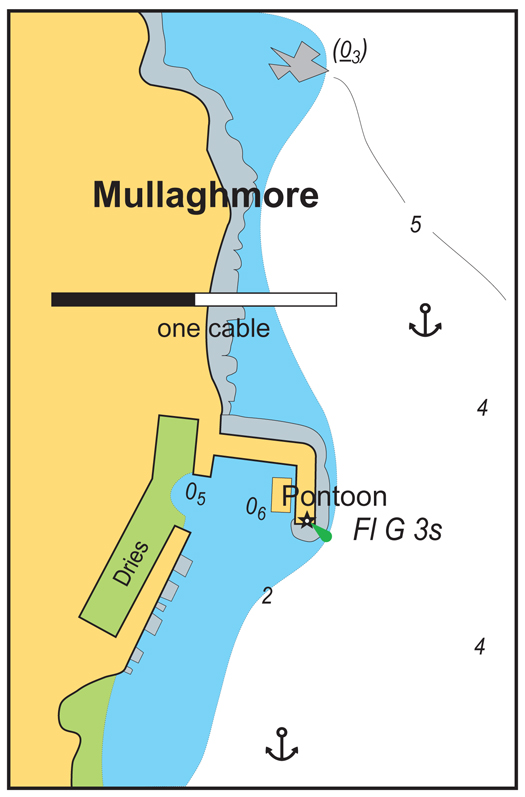
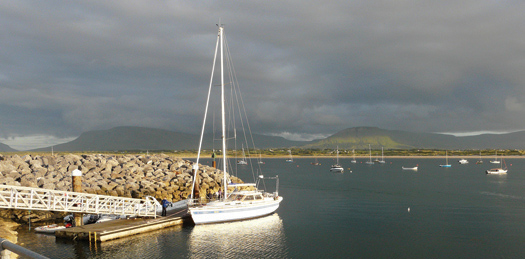
The new pontoon just outside the entrance to Mullaghmore Harbour is a boon for all boat users
From the head of Donegal Bay right round to Lough Swilly, there are some fine harbours, but there isn't another dedicated recreational boating pontoon until you get to Rathmullan in Lough Swilly, with Fahan Marina just across the way. It's only a matter of time before something is installed in Killybegs, and Burtonport up in that lovely area of The Rosses would be strategically useful and the logical place for some facility, ideally one where a boat could be left.
However, up there in that remotest corner of the remote northwest, one of my most convenient crew changes was done at the little fishing port of Kincasslagh. It must be the nearest port to Carrickfin airport, and that's very useful for crews linking to or from Dublin, for this place is cut off by the mountains from any direct roads. Time passes easily as you get up to speed with all the news of The Rosses at Iggy's bar in Kincasslagh, and if there's further delay you can always go and say hello to Daniel O'Donnell who lives nearby. He can tell you more Daniel O'Donnell jokes than anyone else, and tell them better too.

The 13th Edition of the Irish Cruising Club Sailing Directions for the South & West Coasts of Ireland is on sale at €29.95 from all good chandlers or bookshops, or direct from www.iccsailingbooks.com
Comment on this story?
We'd like to hear from you! Leave a message in the box below or email William Nixon directly on[email protected]
WM Nixon's Saturday Sailing blog appears every Saturday on Afloat.ie
Follow us on twitter @afloatmagazine and on our Afloat facebook page
Afloat's Marina Guide Online
We're keen to get reader input on their marina experiences too so we can build a comprehensive picture of the Irish coastal marina and pontoon scene. Can you update our readers with extra information? If so please leave your comments in the box provided for each marina/pontoon listed.


























